
This is a placeholder text
Group text
by Nellie on 12 September 2011 - 11:09
This is my view from over the yrs
by GSDguy08 on 12 September 2011 - 12:09
by Abby Normal on 12 September 2011 - 13:09
IMO the convex back is not conducive to movement with the least fatigue at all. I think it is a shape which in fact requires a lot more effort to move the dog forward - and this is wasted energy. A working dog has no use for a gait which requires using uneccesary energy. But then again the flying trot is not a gait that serves any purpose for work, or would ever be naturally employed by the dog. There is much less extension in the rear legs when a convex shape is present.
If the form of the modern SL was particularly (or in any way) conducive to function surely the Working Lines would want it to perform better. Working line dogs can work in a way that few if any SL can come close to, so you have to ask which of the two forms best serves the function of a working dog. Also as GSDguy says, huskies have a straight back and can RUN for miles each day, as do most other herding breeds who really work, not just run round a ring, or do a short ScH routine. I still haven't heard a valid reason for the arch, just the myths that the breeder of the type convinced everybody of at the time.
Could the arched back simply be a fad that resulted when a top dog won with this fault? - Yes, that is exactly what happened.
The biggest problem is how to reverse the fad and the tendency towards overangulation. As all dogs that compete in Germany look the same, colour and structure, there is no opportunity to 'edit' the template!
by Ibrahim on 12 September 2011 - 14:09
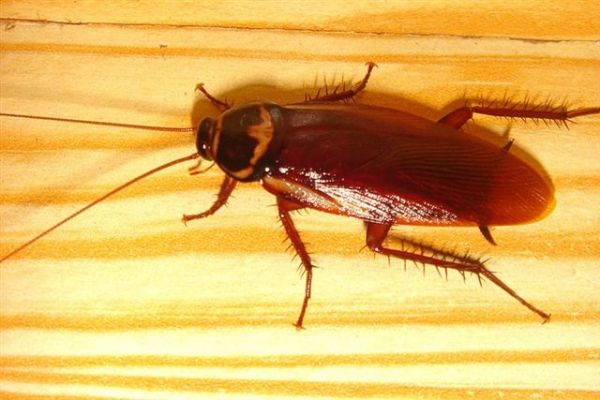
Many people who use the term "roach-back" with relation the GSD use it to mean that anything with a curve is a Roached back and that I think is incorrect.
A GSD is said to have a "roach back" in the true sense only if the point of roach is higher than the withers which should be the highest point in the outline of a GSD. Any other bend in the back is not correct as per the standard but is not a Roach back and is not as faulty in my opinion as a true Roach. I also think watching a GSD gaiting can tell truely whether a GSD's structure is correct or not. Therefore if a GSD is Roached while in movement then that is a fault without any doubt. If a GSD while gaiting shows high withers and straight or very slight sloping then it is absolutely with correct structure or almost correct.
A straight back GSD while in movement having an arched under is best for sustaining fatique and less probability of injury.
in the GSD any movement that wastes energy is not correct and makes GSD movement inefficient. The "roach" or excessive arching lead to inefficiency.
Moreover jumping and galloping require a very firm musculature of the back, dipped back is no good. A sure way to realise this is by looking at how steady the back is when the dog is trotting . One more notice is that as the dog ages the curvature usually becomes less, also if a dip was there it gets bigger and back becomes more prone to injury (hurt of back). For bitches it is very important to have a straight or slightly curved back when young and more important is a slightly curved up under.
by Ibrahim on 12 September 2011 - 14:09
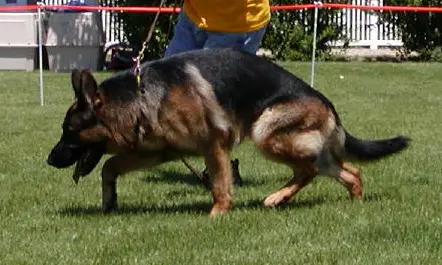
This is a true roached back, it is very evident while in movement, see where the highest point of the back is, it gives you a feeling that the dog might at a point when fatigue takes over it might fall on its head.
by Nellie on 12 September 2011 - 14:09
I have workinglines lol, These are the reasons that have been explained to me every time that i have asked the same question by people in the show ring, My straight backed dogs have never had a problem with being functional, and for the life of me I never have been able to understand the reason for breeding dogs this way, Personaly show dogs have nothing to offer me as a person who is involved in working dogs, Some have realised the mistake Abby and are now trying crossing back to the working line but it is going to run in to a lot of resistance as the Martins brothers ways are still running the SV.
These show lines are a big comodity (sp) earning lots of money
by Ibrahim on 12 September 2011 - 14:09
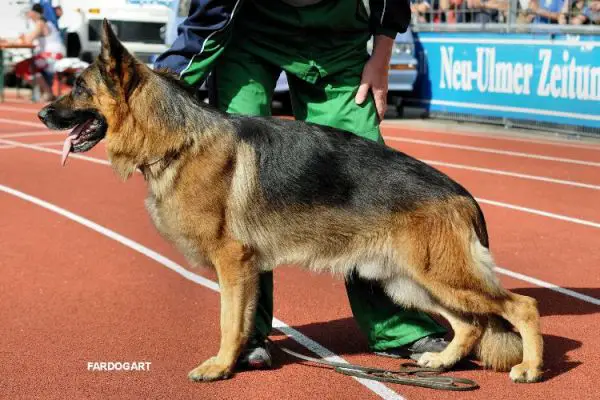
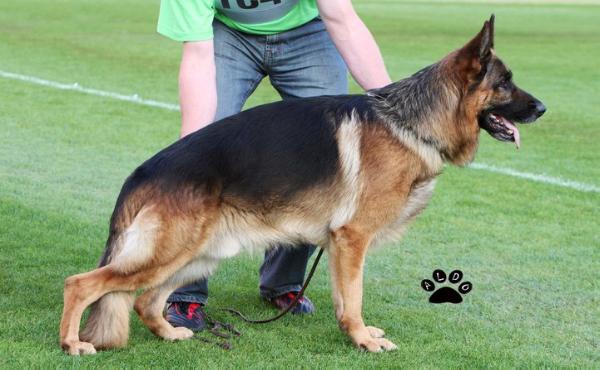
by Ibrahim on 12 September 2011 - 14:09
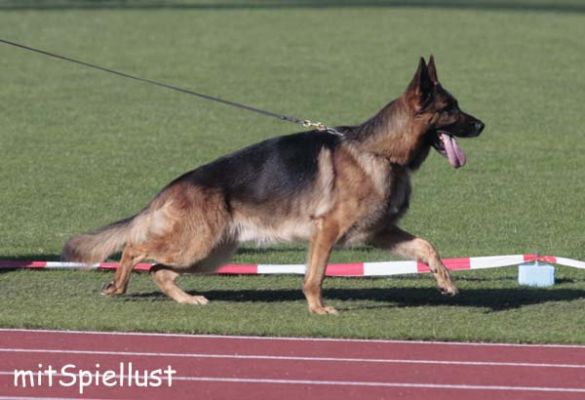
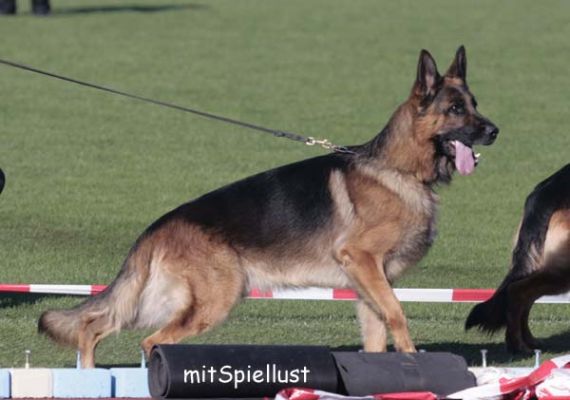
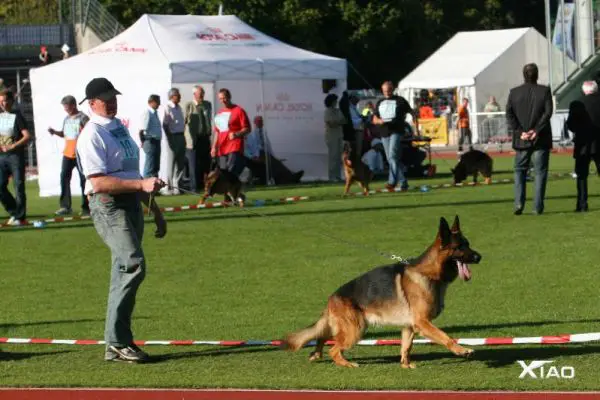
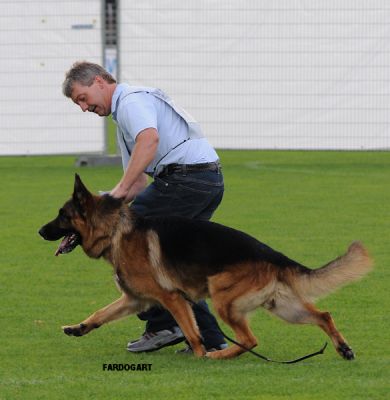
by Ibrahim on 12 September 2011 - 14:09
.jpg)
Just for comparison, the latter has longer better angulated croup, more rear angulation, better upper arm angle and a less open arch (more curvature in standing).
.jpg)
by Sunsilver on 12 September 2011 - 15:09
The roach back (ie upward bowed arch back) is a separate and distinct problem from the faulty rear ends, which are commonly referred to as overangulated. Technically the problem is typically lower thigh bones that are too long (which creates "sickle hocks" which won't open-they look like a scyth sweeping from the side). Roach backs were selectively bred as an over compensation for the long and weak backs of Rolf Onsnabruckerland (Rolf had exceptional working temperament, but the long flexible, weak backs he produced seriously limited the working ability of a certain percentage of his progeny and was identified as a very serious fault). The GSD has always had a serious problem with either long excessively flexing backs or backs that are weak at a certain point such as right behind the withers. The roach back is a quick and faulty breeding solution for this and can actually add steepness to the croup, making the dog rollup of the rump, causing an imbalance between the front and rear, often resulting in a hitch in the rear that can look like HD.
It is very difficult to breed a GSD with a short, strong back that is relatively straight as specified in the standard. It is a major current flaw in a high percentage of SL and WL dogs, including the top competitors. The roach back problem is also a very serious problem, but if it is not too pronounced can be quite easily covered up with a lot of conditioning on a tight lead pulling, and then showing the GSD on a tight lead in the showring. If the roach is too pronounced the result is a front that drops under power of the rear drive and roll-up of the rump, either of which can create pounding or padding in front and impair movement making it less efficient. Germans demand strong backs and now tend to favor roaches as a form of insurance against a GSD "breaking down" in the back. Over time through selective incremental perceptual drift, they have come to actually see serious roach backs as okay and even normal, when they actually are an aberration to the standard and cause the GSD to look grossly distorted.
Source:http://www.pedigreedatabase.com/german_shepherd_dog/bulletins.read?mnr=221753&pagen=19
Contact information Disclaimer Privacy Statement Copyright Information Terms of Service Cookie policy ↑ Back to top




